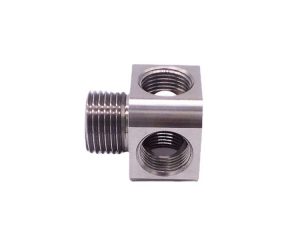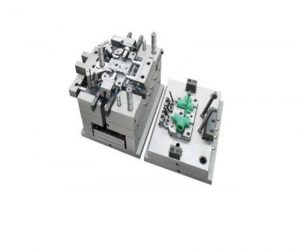A plastic mould is a tool for producing plastic products. It consists of several sets of parts with a moulding cavity. During the injection moulding process, the mould is clamped to the injection moulding machine, the molten plastic is injected into the moulding cavity, where it is cooled and moulded, then the upper and lower moulds are separated, the product is ejected from the cavity by an ejection system, and finally the mould is closed for the next injection. The whole injection moulding process is cyclic.
Generally, if there are ready-made mould templates for plastic mould machining, you only need to machine the cavities and cores, and the clampers can drill the holes for assembly. If everything is started from scratch, it is necessary to start undercutting, milling, planing, grinding and contouring of the template, and then start machining the cavities and cores. Cavities and cores are generally machined by wire cutting, electrical discharge, CNC milling machine or machining centre.
Warm tips: the precision of plastic mould machining is different from that of machining machine, and the precision is also different. Current CNC: 0.002MM; EDM: 0.01MM; slow moving: 0.005MM; manual milling machine: 0.02MM; drilling machine: 0.05MM; 0.005MM grinder; lathe is 0.01MM, each is different.
Plastic mould is an essential tool in the manufacturing process of plastic products. It is a device for manufacturing plastic products by moulding molten plastic into a desired shape. In this article, we will discuss plastic moulds, their importance in the manufacturing process, and the different types of them.
What is a Plastic Mold?
A plastic mould is a tool used to mould molten plastic into a specific shape. It consists of two halves, the core and the cavity. The core is the part of the mould that is used to shape the inside of the plastic product, while the cavity is used to shape the outside. The mould is designed according to the specifications of the plastic product to be produced.
Importance of Plastic Mold in the Manufacturing Process
Plastic molds play a crucial role in the manufacturing process of plastic products. They offer several advantages, including:
- Cost-Effective Production
Plastic moulds are cost-effective in producing plastic products in large quantities. Once the mould is made, it can produce multiple identical plastic products at a low unit cost.
Firstly, the process of making plastic moulds is relatively simple and low cost. Compared to traditional metal moulds, plastic moulds are easier to make and require more economical materials and processes. This makes plastic moulds a cost-effective production method, especially for plastic products that require mass production.
Secondly, plastic moulds are highly durable and reusable. Once a mould is made, it can be used for multiple production runs without frequent replacement or repair. This durability makes plastic moulds a reliable production tool that ensures product consistency and quality.
Additionally, plastic moulds have a short production cycle and fast production capacity. Compared to other production methods, such as handmade or machined, plastic moulds can produce large quantities of plastic products in a shorter period of time. This makes plastic moulds ideal for meeting market demand and responding to urgent orders.
Finally, plastic moulds also allow for diverse designs and customisation. Due to their flexibility, plastic moulds can be customised to suit different needs and specifications, resulting in the production of plastic products of all shapes, sizes and functions. This diversity allows plastic moulds to meet the needs of different industries and consumers, providing a wider range of product options.
To sum up, plastic moulds are cost-effective in the mass production of plastic products. Not only does it offer low production costs and durability, it is also able to produce multiple identical plastic products quickly and allows for diverse designs and customisation. This makes plastic moulds an economical, reliable and flexible production tool that is widely used in various fields.
- Versatile
Plastic molds are versatile, allowing the production of plastic products in various shapes and sizes. They can be customized to produce different types of products according to the customer's specifications.
- High-Quality Products
Plastic molds are capable of producing high-quality plastic products with consistent dimensions and properties. The use of advanced technology in designing and creating molds ensures the products meet the required quality standards.
Types of Plastic Molds
There are different types of plastic molds used in the manufacturing process, each with its unique advantages. The most common types include:
- Injection Molds
Injection moulds are the most commonly used type of plastic mould in the manufacturing process. They are used to produce complex plastic products that require high precision and consistency. Injection moulds are created through a combination of computer-aided design (CAD) and computer-aided manufacturing (CAM) software.
Injection moulds have a wide range of applications in the plastics manufacturing industry as they are efficient in producing plastic parts with complex shapes and precise dimensions. These moulds are usually made of high quality steel to ensure their durability and stability.
The process of manufacturing injection moulds begins with the use of computer-aided design (CAD) software. The CAD software is used by the designer to create a three-dimensional model of the product and to determine the dimensions and shapes of the various components of the mould. This design process takes into account factors such as product geometry, wall thickness, and gate locations to ensure the quality of the final product.
Once the design is complete, the next step is to convert the design into actual instructions for manufacturing the mould using Computer Aided Manufacturing (CAM) software.The CAM software generates numerical control (NC) programming codes that direct the CNC machine tool to process the mould. The CNC machine tool cuts and machines each part of the mould precisely according to the instructions in the code, including the mould cavities, cores, and cooling system.
The process of manufacturing injection moulds requires a high degree of precision and expertise. Mould makers need to have extensive experience and technical knowledge to ensure the quality and performance of the mould. They need to exercise fine control over the selection of mould materials, the optimisation of the machining process and the assembly and commissioning of the mould.
One of the advantages of injection moulds is their repeatability. Once a mould has been made, it can be used many times over to produce large quantities of the same plastic product. This makes injection moulds ideal for mass production as they offer high efficiency and consistency in the manufacture of products.
Overall, injection moulds play an important role in plastic manufacturing. They make it feasible to manufacture complex plastic products by combining computer-aided design and computer-aided manufacturing software. The precision and consistency of injection moulds make them an indispensable tool in the plastics manufacturing industry, providing high-quality, high-performance plastic products for a variety of industries.
- Blow Molds
Blow moulds are widely used to produce plastic products with hollow centres, such as plastic bottles. The process involves heating a tube of plastic material and then blowing it into the shape of a mould. Blow moulds are usually made of aluminium or steel and are designed to fit the shape of the product to be produced.
Blow moulding is an advanced manufacturing technique that can efficiently produce plastic products of various shapes and sizes. These moulds are designed with great precision to ensure the quality and consistency of the final product. In the manufacturing process, the plastic material tube is first heated to the right temperature to make it soft and malleable. The plastic is then blown into the mould by means of high pressure air, which expands and fills the entire mould cavity.
Blow moulds are usually made of high-quality materials, such as aluminium or steel, to ensure their durability and stability. Not only do these materials provide sufficient strength and rigidity, they are also able to withstand high temperatures and high pressure conditions. It is also vital that the design of the blow mould takes into account the shape, size and functional requirements of the product. Designers will tailor the shape and structure of the mould to suit the needs of the product to ensure that the final product meets the expected performance criteria.
The blow mould plays a key role in the blow moulding process. It not only determines the shape and size of the product, but also affects the appearance and quality of the product. Therefore, the manufacture and maintenance of blow moulds require a high degree of expertise and technology. Manufacturers usually use advanced processing technology and equipment to manufacture blow moulds to ensure their precision and quality. Meanwhile, regular maintenance and servicing are also crucial to ensure the performance of the moulds.
Overall, blow moulds are important tools for producing plastic products with high efficiency, precision and reliability. Through reasonable design and manufacture, blow moulds can produce plastic products of various shapes and sizes to meet the needs of different fields. Whether it is beverage bottles, cosmetic containers or automotive parts, blow moulds can provide excellent solutions.
- Compression Molds
A compression mould is a tool used to produce low to medium output plastic products. In this process, a preheated plastic material is first placed into the mould and then pressure is applied to press it into the desired shape. Compression moulds are usually made of steel and are ideal for producing large and thick plastic products.
During the compression moulding process, the plastic material is heated to a temperature above its melting point, making it soft and easy to shape. The preheated material is then placed into a mould, which consists of two or more parts that can be tightly closed together. Once the mould is closed, pressure is applied to the material to press it into the desired shape. This pressure can be applied either by a mechanical device or a hydraulic system to ensure uniform pressure distribution and accurate shape reproduction.
The design and manufacture of compression moulds needs to take into account the specific requirements of the product and the characteristics of the production process. Moulds are usually made of high-strength steel to ensure durability and stability at high temperatures and pressures. The internal surfaces of the mould need to be finely machined to ensure the quality of the product's appearance and dimensional accuracy. In addition, moulds need to have good thermal conductivity in order to transfer heat efficiently during the production process.
Compression moulds are suitable for the production of various types of plastic products, including large sheets, containers, pipes, automotive parts and so on. Due to their ability to produce thick and robust products, compression moulds are widely used in many industrial sectors. Whether in the construction industry, automotive industry or medical device manufacturing, compression moulds play an important role.
Overall, compression moulds are an efficient and reliable tool for producing low to medium volume plastic products. By placing preheated plastic material into the mould and applying pressure, a plastic product of the desired shape can be obtained. Compression moulds are usually made of steel, which provides high strength and durability, making them ideal for producing large and thick plastic products. Compression moulds shape the world around us, both in industrial production and in everyday life.
- Transfer Molds
Transfer molds are used to produce plastic products with high precision and consistency. The process involves transferring the plastic material from a chamber into the mold cavity using a plunger. Transfer molds are typically used for producing small and intricate plastic products.
Conclusion
Plastic moulds are essential tools in the manufacturing process of plastic products. They offer several advantages including cost-effective production, versatility and high quality products. Different types of moulds are used in the manufacturing process, each with their own unique advantages. By choosing the right type of mould for the product to be produced, manufacturers can ensure that they produce high quality plastic products that meet the required standards.



